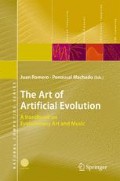Summary
Swarm granulation, as a union of swarming behaviour and sonic granulation, holds much potential for the generation of novel sounds. Theoretical and practical aspects of this technique are outlined here, and an explanation of how musical interactions with swarms can be enabled using an analogue of the biological process of stigmergy. Two manifestations of swarm granulation are explained in some detail. Social criticality, an inter-particle communication that is driven by a critical system such as a sandpile, and its use in determining the rendering of sound grains, is introduced.
Access this chapter
Tax calculation will be finalised at checkout
Purchases are for personal use only
Preview
Unable to display preview. Download preview PDF.
Reference
Blackwell, T.M., Young, M. (2004). Swarm granulator. In Raidl, G.R., ed.: Applications of Evolutionary Computing. Vol. 3005 of LNCS. Springer, 399–408
Grassé, P. (1959). La reconstruction du nid et les coordinations inter-individuelles chez bellicosi-termes natalensis et cubitermes sp. la theorie de la stigmergie: essai d’interpretation des termites constructeurs. Insect Societies, 6: 41–83
Blackwell, T.M., Jefferies, J. (2005). Swarm tech-tiles. In Rothlauf, R., ed.: Applications of Evolutionary Computing. Vol. 3449 of LNCS. Springer, 468–251
Kennedy, J., Eberhart, R. (1995). Particle swarm optimization. In: Proceedings of the 1995 IEEE International Conference on Neural Networks, 1942–1948
Rowe, R., Singer, E. (1997). Two highly-related real-time music and graphics performance systems. In: Proc. Int’l Computer Music Conf., 133–140
Spector, L., Klein, J. (1997). Complex adaptive music systems in the breve simulation environment. In Bilotta, et al., eds.: 8th Int’l Conf. on the Simulation and Synthesis of Living Systems. University of New South Wales, 167–170
Blackwell, T.M., Bentley, P. (2002). Improvised music with swarms. In: Congress on Evolutionary Computation, 1462–1467
Unemi, T., Bisig, D. (2005). Playing by interaction among two flocking species and a human. In: Proc. of the Third Int’l Conf. on Generative Systems in Electronic Arts, 171–179
Blackwell, T.M. (2006). http://art-of-artficial-evolution.doc.gold.ac.uk/
C.Reynolds (1987). Flocks, herds and schools: a distributed behavioral model. Computer Graphics, 21: 25–34
I. Couzin, K. Krause, G.R.G., Franks, N. (2002). Collective memory and spatial sorting in animal groups. J. Theor. Biol., 218: 1–11
E.Bonabeau, M., G.Theraulaz (1999). Swarm Intelligence. Oxford University Press
J. Kennedy, R., Y.Shi (2001). Swarm Intelligence. Morgan Kaufmann
Clerc, M. (2006). Particle Swarm Optimization. ISTE publishing company
Blackwell, T.M., Bentley, P.J. (2002). Dynamic search with charged swarms. In Langdon, W.B., et al., eds.: Genetic and Evolutionary Computation Conference. Morgan Kaufmann, 19–26
Bourg, D., Seeman, G. (2004). AI for Game Developers. O’Reilly
Jost, E. (1974). Free Jazz. Da Capo
Bailey, D. (1992). Improvisation: its Nature and Practice in Music. The British Library Sound Archive, London
Blackwell, T.M., Young, M. (2004). Self-organised music. Organised Sound 9, 9: 123–136
Theraulaz, G., Bonabeau, E. (1995). Coordination on distributed building. Science, 269: 686–688
Blackwell, T.M., Young, M. (2005). Live algorithms. Society for the Study of Artificial Intelligence and Simulation of Behaviour Quarterly, 122: 7
Gabor, D. (1947). Acoustical quanta and the theory hearing. Nature, 159: 591–594
Miranda, E. (1998). Computer Sound Synthesis for the Electronic Musician. Focal Press
Roads, C. (2001). Microsound. CUP
R. Jain, R. Kasturi, J.S. (1995). Machine Vision. McGraw-Hill
Manaris, B., Vaughan, D., Wagner, C., Romero, J., Davis, R. (2003). Evolutionary music and the zipf-mandelbrot law: developing fitness functions for pleasant music. In Rothlauf, R., et al., eds.: EvoWorkshops. Vol. 2611 of LNCS. Springer, 522–534
Bak, P. (1996). How Nature Works: The Science of Self-Organized Criticality. Copernicus Press
Bak, P., Tang, C., Wiesenfeld, K. (1987). Self-organized criticality: an explanation of the 1/f noise. Phys. Rev. Lett., 59: 381–384
Lovbjerg, M., Krink, T. (2002). Extending particle swarm optimizers with self-organized criticality. In: Proc. Congress on Evolutionary Computation. IEEE, 1588–1593
Author information
Authors and Affiliations
Editor information
Editors and Affiliations
Rights and permissions
Copyright information
© 2008 Springer-Verlag Berlin Heidelberg
About this chapter
Cite this chapter
Blackwell, T. (2008). Swarm Granulation. In: Romero, J., Machado, P. (eds) The Art of Artificial Evolution. Natural Computing Series. Springer, Berlin, Heidelberg. https://doi.org/10.1007/978-3-540-72877-1_5
Download citation
DOI: https://doi.org/10.1007/978-3-540-72877-1_5
Publisher Name: Springer, Berlin, Heidelberg
Print ISBN: 978-3-540-72876-4
Online ISBN: 978-3-540-72877-1
eBook Packages: Computer ScienceComputer Science (R0)

